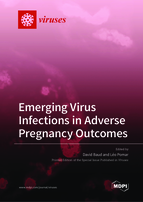Emerging Virus Infections in Adverse Pregnancy Outcomes
A special issue of Viruses (ISSN 1999-4915). This special issue belongs to the section "Human Virology and Viral Diseases".
Deadline for manuscript submissions: closed (31 July 2021) | Viewed by 58974
Special Issue Editors
Interests: emerging pathogens; zika; chlamydia; SARS-COV-2; maternal-fetal medicine
Special Issues, Collections and Topics in MDPI journals
2. School of Health Sciences (HESAV), University of Applied Sciences and Arts Western Switzerland, Lausanne, Switzerland
Interests: emerging pathogens; zika; arboviruses; SARS-COV-2; fetal neurology
Special Issues, Collections and Topics in MDPI journals
Special Issue Information
Dear Colleagues,
Viruses that emerged in the past decades, such as arboviruses and SARS-coronaviruses, are increasingly recognized as potential risk factors for adverse pregnancy outcomes.
On the fetal side, arboviruses have proved their ability to cross the placental barrier, at different stages of pregnancy, and have been associated with fetal losses, fetal malformations (Zika, West Nile, and Venezuelan equine encephalitis viruses) and adverse neonatal outcomes (Dengue and Chikungunya viruses). The SARS-COV-2 has also be associated with rare maternal-fetal transmission and placental affection leading to fetal losses. More common viruses, like cytomegalovirus, are also well-known causes of fetal and childhood sequelae, and recent research on its prognosis factors and in-utero treatment may be welcome.
On the maternal side, SARS-COV-2 might compromise maternal health, as well as Dengue viruses have been associated with high risks of adverse obstetrical outcomes, including maternal death, pre-eclampsia or post-partum hemorrhage. Thus, research on the maternal physiopathology would also be welcome.
In this Special Issue of Viruses, we aim for original researchs, reviews and commentaries that contribute to an improved understanding of viral infection of placenta and fetal cells, or that report on the maternal and fetal outcomes after an emerging viral infection during pregnancy.
Prof. Dr. David Baud
Prof. Dr. Leó Pomar
Guest Editors
Manuscript Submission Information
Manuscripts should be submitted online at www.mdpi.com by registering and logging in to this website. Once you are registered, click here to go to the submission form. Manuscripts can be submitted until the deadline. All submissions that pass pre-check are peer-reviewed. Accepted papers will be published continuously in the journal (as soon as accepted) and will be listed together on the special issue website. Research articles, review articles as well as short communications are invited. For planned papers, a title and short abstract (about 100 words) can be sent to the Editorial Office for announcement on this website.
Submitted manuscripts should not have been published previously, nor be under consideration for publication elsewhere (except conference proceedings papers). All manuscripts are thoroughly refereed through a single-blind peer-review process. A guide for authors and other relevant information for submission of manuscripts is available on the Instructions for Authors page. Viruses is an international peer-reviewed open access monthly journal published by MDPI.
Please visit the Instructions for Authors page before submitting a manuscript. The Article Processing Charge (APC) for publication in this open access journal is 2600 CHF (Swiss Francs). Submitted papers should be well formatted and use good English. Authors may use MDPI's English editing service prior to publication or during author revisions.
Keywords
- emerging pathogens
- arboviruses
- coronaviruses
- fetal demises
- birth defects
- adverse maternal outcomes
- adverse fetal outcomes







